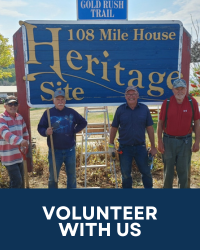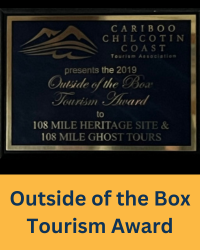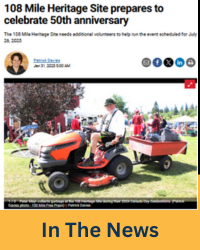1863 -1871
- 1863 William J. Roper pre-empted 320 acres D.L. 76
- 1867 Built log 108 Roadhouse ("108 Hotel") north of the road. (Across the hwy. from the present day 108 Heritage Site).
- 1867 Built log stable and log shed north of the road (Across the hwy. from this site).
- 1871 Quit 108 moved to Cherry Creek near Kamloops.
1871 -1880
No evidence of ownership
1875 -1885
- 1875 "108 Hotel" ran by AGNUS MACVEE. Jim MacVee, and her brother-in-law Al Riley till June 1885.
- 1880 Evidence that William Walker owned the 108.
1880 -1891 WALKER
- 1880 WILLIAM WALKER PRE-EMPTED 320 acres D.L. 76. He was a telegraph operator, stockraiser, dairy farmer, trader and 'BX Agent'.
- 1880 Built log dairy **ICE HOUSE** on this site.
- 1880 Tore down "1867" Roper log shed" north of the road and re-assembled it on this site for the ** store and ** TELEGRAPH OFFICE ** Rumor has it, he was looking for gold buried by Agnus MacVee.
- 1880 Black Smith Shop
- 1891 Walker sold the 108 on December 30 to Stephen Tingley for $320.00
1891-1903 TINGLEY
- 1891 STEPHEN TINGLEY bought D.L. 76 (108) and his son Clarence ran itCLARENCE was a telegraph operator, 'BX Agent', dairy farmer, stockraiser, storekeeper and hotel keeper.
- 1892 Tore down "Roper" '1867' Hotel" north of road, & re-assembled on this site for **108 POSTHOUSE** with a single story extension that contained the kitchen and eating area. This extension has not (as yet) been replaced by the Society.
- 1892 Built **SMALL LOG BARN** on this site.
- 1892 Built large log BX Stable south of road. This log structure burned down 1904-1908 and was situated in the exact spot the **105 HERITAGE HOUSE** is located.- Built frame blacksmith shop- Built log "BUNKHOUSE"
- 1903 Clarence Tingley sold D.L. 76 (108) September 23 to Captain Watson (including 13 other lots) for $11,000.
1903 -1915 WATSON
- 1903 CAPTAIN GEOFFREY LANCELOT WATSON bought WATSON District Lot 76.
- 1904 Built the 'Watson Manor' four miles away, at Watson Lake, and turned his attention to ranching.
- 1904-08 "Tingley's 1892 large log BX Stable" burned down.
- 1904 The 108 ceased to be a Roadhouse and stopping place. Captain Watson turned it into a Ranch. He was breeder of purebred Clydesdale horses and Highland Cattle.
- 1905 Tore down the 'Roper' 1867 log stable north of the road and destroyed it.
- 1908 The large log "CLYDESDALE BARN** was built by Gilbert Monroe of Ashcroft for Captain Watson.
- 1915 Captain Watson was killed in WW1 in 1915
Did you know?
The spelling of the Cariboo Waggon Road with two g's in Waggon is historically correct?
And also mile zero of the Cariboo Waggon Road starts at Lillooet, BC.
History of the buildings on site. Click the links below to check them out.





